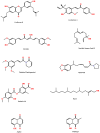Therapeutic Potential of Natural Products in the Treatment of Schistosomiasis
- PMID: 37836650
- PMCID: PMC10574020
- DOI: 10.3390/molecules28196807
Therapeutic Potential of Natural Products in the Treatment of Schistosomiasis
Abstract
It is estimated that 250 million people worldwide are affected by schistosomiasis. Disease transmission is related to the poor sanitation and hygiene habits that affect residents of impoverished regions in tropical and subtropical countries. The main species responsible for causing disease in humans are Schistosoma Mansoni, S. japonicum, and S. haematobium, each with different geographic distributions. Praziquantel is the drug predominantly used to treat this disease, which offers low effectiveness against immature and juvenile parasite forms. In addition, reports of drug resistance prompt the development of novel therapeutic approaches. Natural products represent an important source of new compounds, especially those obtained from plant sources. This review compiles data from several in vitro and in vivo studies evaluating various compounds and essential oils derived from plants with cercaricidal and molluscicidal activities against both juvenile and adult forms of the parasite. Finally, this review provides an important discussion on recent advances in molecular and computational tools deemed fundamental for more rapid and effective screening of new compounds, allowing for the optimization of time and resources.
Keywords: essential oil; molecular tools; natural compounds; schistosomiasis.
Conflict of interest statement
The authors declare no conflict of interest.
Figures



Similar articles
-
Schistosomiasis: Drugs used and treatment strategies.Acta Trop. 2017 Dec;176:179-187. doi: 10.1016/j.actatropica.2017.08.002. Epub 2017 Aug 10. Acta Trop. 2017. PMID: 28803725 Review.
-
Praziquantel treatment of school children from single and mixed infection foci of intestinal and urogenital schistosomiasis along the Senegal River Basin: monitoring treatment success and re-infection patterns.Acta Trop. 2013 Nov;128(2):292-302. doi: 10.1016/j.actatropica.2012.09.010. Epub 2012 Sep 26. Acta Trop. 2013. PMID: 23022016
-
The impact of single versus mixed schistosome species infections on liver, spleen and bladder morbidity within Malian children pre- and post-praziquantel treatment.BMC Infect Dis. 2010 Jul 29;10:227. doi: 10.1186/1471-2334-10-227. BMC Infect Dis. 2010. PMID: 20670408 Free PMC article.
-
Impact of Schistosoma mansoni on malaria transmission in Sub-Saharan Africa.PLoS Negl Trop Dis. 2014 Oct 16;8(10):e3234. doi: 10.1371/journal.pntd.0003234. eCollection 2014 Oct. PLoS Negl Trop Dis. 2014. PMID: 25329403 Free PMC article.
-
Schistosomiasis.Infect Dis Clin North Am. 2012 Jun;26(2):383-97. doi: 10.1016/j.idc.2012.03.004. Infect Dis Clin North Am. 2012. PMID: 22632645 Review.
Cited by
-
Chemical Control of Snail Vectors as an Integrated Part of a Strategy for the Elimination of Schistosomiasis-A Review of the State of Knowledge and Future Needs.Trop Med Infect Dis. 2024 Sep 20;9(9):222. doi: 10.3390/tropicalmed9090222. Trop Med Infect Dis. 2024. PMID: 39330911 Free PMC article. Review.
References
-
- Lo N.C., Bezerra F.S.M., Colley D.G., Fleming F.M., Homeida M., Kabatereine M., Kabole F.M., King C.H., Mafe M.A., Midzi M., et al. Review of 2022 WHO guidelines on the control and elimination of schistosomiasis. Lancet Infect Dis. 2022;22:e327–e335. doi: 10.1016/S1473-3099(22)00221-3. - DOI - PubMed
Publication types
MeSH terms
Substances
LinkOut - more resources
Full Text Sources

